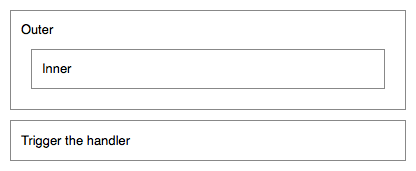.mouseout( handler(eventObject) ) Returns: jQuery
Description: Bind an event handler to the "mouseout" JavaScript event, or trigger that event on an element.
-
version added: 1.0.mouseout( handler(eventObject) )
-
handler(eventObject)Type: Function()A function to execute each time the event is triggered.
-
-
version added: 1.4.3.mouseout( [eventData ], handler(eventObject) )
-
eventDataType: PlainObjectAn object containing data that will be passed to the event handler.
-
handler(eventObject)Type: Function()A function to execute each time the event is triggered.
-
-
version added: 1.0.mouseout()
-
This method does not accept any arguments.
-
This method is a shortcut for .on('mouseout', handler) in the first two variation, and .trigger('mouseout') in the third.
The mouseout event is sent to an element when the mouse pointer leaves the element. Any HTML element can receive this event.
For example, consider the HTML:
|
1
2
3
4
5
6
7
8
9
10
|
|

The event handler can be bound to any element:
|
1
2
3
|
|
Now when the mouse pointer moves out of the Outer <div>, the message is appended to <div id="log">. To trigger the event manually, apply .mouseout() without an argument::
|
1
2
3
|
|
After this code executes, clicks on Trigger the handler will also append the message.
This event type can cause many headaches due to event bubbling. For instance, when the mouse pointer moves out of the Inner element in this example, a mouseout event will be sent to that, then trickle up to Outer. This can trigger the bound mouseout handler at inopportune times. See the discussion for .mouseleave() for a useful alternative.
Example:
Show the number of times mouseout and mouseleave events are triggered. mouseout fires when the pointer moves out of the child element as well, while mouseleave fires only when the pointer moves out of the bound element.
|
1
2
3
4
5
6
7
8
9
10
11
12
13
14
15
16
17
18
19
20
21
22
23
24
25
26
27
28
29
30
31
32
33
34
35
36
37
38
39
40
41
42
43
44
45
46
47
48
49
50
51
52
53
|
|